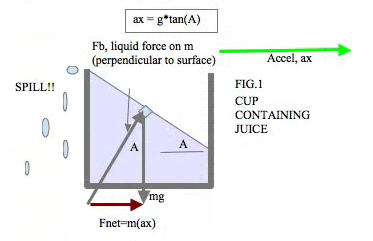 by: Evan Jones
by: Evan Jones
How the SpillNot works:
When you hold a cup of juice while walking, the juice tends to spill because the cup accelerates forward (ax, FIG.1, green arrow) and backward (-ax) with each step. The juice tips in response to that acceleration, and may spill over the rim of the cup.
 The Spill Not automatically tips the cup so that its top stays parallel to the juice surface (FIG.2). For example, if the juice surface tips to 30 deg, but the cup stays horizontal, the juice could spill. But if the cup also tips to 30 deg, we get no spill! Note that there are only 2 forces on each portion m of juice…the weight mg down, and the buoyancy force Fb of the juice pushing at a right angle to the surface. These two forces result in a horizontal accelerating force ma (in red). We see from FIG.1 that
The Spill Not automatically tips the cup so that its top stays parallel to the juice surface (FIG.2). For example, if the juice surface tips to 30 deg, but the cup stays horizontal, the juice could spill. But if the cup also tips to 30 deg, we get no spill! Note that there are only 2 forces on each portion m of juice…the weight mg down, and the buoyancy force Fb of the juice pushing at a right angle to the surface. These two forces result in a horizontal accelerating force ma (in red). We see from FIG.1 that
Experiment 1. Build a Circular Carnival Ride
Hang the SpillNot on a string about 0.50 m long. Place a lump of molding clay on the pan, to be the “rider.” Swing the SpillNot around in front of you in a horizontal circle of about 0.20 m radius. With a smartphone, take a photo so angle A shows in its true size (see diag below). From the photo, measure the angle A with a protractor. The forces on the rider are similar to those on a mass m of juice in Fig.2 above, and you can calculate the centripetal acceleration ac (ax) of the SpillNot “carnival rider” from ac= g*tan(A).
A=_____deg ac = g*tan(A)=__________m/s^2
Expt. 2. Build a banked race track…Road curves may be banked for safety, so that at a certain speed no friction between tire and roadway is needed to prevent sliding up or down the bank. At this speed the force of the road Fr is at a right angle to the road surface. The SpillNot illustrates banking of curves to keep vehicles from sliding, because it “banks” at the correct angle A. The SpillNot, banked road turns, and banked airplane turns all obey a similar acceleration equation.
Refer to Expt. 1 above for the experimental technique to find angle A…this time use radius of about 0.30 m; then calculate ax = g*tan(A)
A =_____deg ax = g*tan(A)=__________m/s^2
ma = net force on m
Expt. 3. Build a model loop-the-loop (to avoid messy accidents, perform this experiment with a penny, not water, on the pan of the SpillNot) You can rotate the SpillNot in a vertical circle, just as you may have experienced with some amusement park rides. Again, use the 0.5 m string extension, as in Expt 1 above. Beyond a certain speed Vmin at the top, the penny can do a loop-the-loop without falling off the pan…amaze your friends with this trick!
For your loop-the-loop, this minimum speed is Vmin = √ (g(R)).
R=_________m Vmin=_______m/s
Expt 4. Measure the acceleration of a car: In a car, suspend the SpillNot from the short cord provided. As the car accelerates, photograph the Spillnot so that you can measure the true size of the angle between the cord and the vertical. As the car accelerates forward, notice that the SpillNot is pulled forward, like a puppy being pulled forward on a leash. As the car brakes, the SpillNot is pulled backward, and the direction of the acceleration is backward. As the car turns right/left, the SpillNot is pulled to the right/left, and the direction of the acceleration is to the right/left. From the photo for each case, measure the angle A of the SpillNot. See diagram below. ax = g*tan(A). This gives
For forward acceleration, Angle A=_______ ax = _________m/s^2
For backward acceleration, Angle A=______ ax = _________m/s^2
For radial(centripetal, sideways) acceleration, Angle A = ________ ax = _________m/s^2
Expt 5. Pendulum(more advanced): (See The Physics Teacher magazine, vol. 52, Nov. 2014, pg. 502-503). Securely attach a smartphone to the SpillNot, so it lies flat on the SpillNot pan. Orient the smartphone so that an axis of its accelerometer is aligned with its motion. Use the Android Samsung GT-19100, with Androsensor recorder. Using SpillNot as a simple pendulum, measure radial acceleration (ar). Plot (ar) and (at) vs time for pendulum motion from 90 deg (horizontal) through the lowest point at 0 deg, and back to 90 deg. Subtract off “g” from all recorded values of acceleration to obtain true values of acceleration.
The Spill-Not is available from Educational Innovations. For more information, click here.
Evan Jones enjoyed many years of physics teaching at Sierra College, Rocklin, CA. His classes emphasized the application of physics to our familiar world: What is lightning? How do musical instruments work? What causes the many different flower colors? How do birds fly? Today, he continues to search for new ways in which students can find pleasure and deeper understanding in their studies of the wonderful rules of the physical world.









Will it work on a bicycle ?
It sure will!